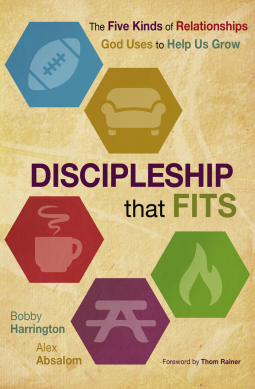
Discipleship That Fits
The Five Kinds of Relationships God Uses to Help Us Grow
by Bobby William Harrington, Alex Absalom
This title was previously available on NetGalley and is now archived.
Send NetGalley books directly to your Kindle or Kindle app
1
To read on a Kindle or Kindle app, please add kindle@netgalley.com as an approved email address to receive files in your Amazon account. Click here for step-by-step instructions.
2
Also find your Kindle email address within your Amazon account, and enter it here.
Pub Date Feb 09 2016 | Archive Date Aug 22 2017
Zondervan Academic | Zondervan
Description
For far too long, the church has tried to make disciples using a one-size-fits-all approach. Some churches advocate 1-on-1 discipling, others try getting everyone into a small group, while still others training through mission trips or service projects. Yet others focus all their efforts on attracting people to a large group gathering to hear biblical teaching and preaching. But does one size really fit everyone?
Based on careful biblical study and years of experience making disciples in the local church, Bobby Harrington and Alex Absalom have identified five key relationships where discipleship happens in our lives. In each relational context we need to understand how discipleship occurs and we need to set appropriate expectations for each context.
Discipleship That Fits shows you the five key ways discipleship occurs. It looks at how Jesus made disciples and how disciples were formed in the early church. Each of the contexts is necessary at different times and in different ways as a person grows toward maturity in Christ:
- Public Relationships: The church gathering corporately for worship
- Social Relationships: Networks of smaller relationships where we engage in mission and live out our faith in community
- Personal Relationships: Small groups of six to sixteen people where we challenge and encourage one another on a regular basis
- Transparent Relationships: Close relationships of three to four where we share intimate details of our lives for accountability
- The Divine Relationship: Our relationship with Jesus Christ where we grow through the empowering presence of the Holy Spirit
Filled with examples and stories, Alex and Bobby show you how to develop discipleship practices in each relational context by sharing how Jesus did it, how the early church practiced it, and how churches are discipling people today.
Available Editions
| EDITION | Paperback |
| ISBN | 9780310522614 |
| PRICE | $16.99 (USD) |
Average rating from 11 members
Featured Reviews
 Paul S, Educator
Paul S, Educator
The key idea of Discipleship that Fits is that God uses various sized groups to disciple us and move us along in our journey to being more and more conformed to the image of Christ. This isn’t a new idea, I think I first read about it in Neil Cole’s book Church 3.0 and I doubt it was new then. Nevertheless, this is a great book that introduces this concept very well. It also is a book that is written for “normal” people and not just leaders.
They layout the five distinct contexts as:
Public: this could number in the hundreds. This is a great place for celebration.
Social: 20 to 70. This is an ideal size for ministry to take place (not too big and not too small). This is the missing grouping in many larger churches.
Personal: 4 to 12. This is the traditional small group size. Relationships are key at this level.
Transparent: 2 to 4. This is the level where authenticity and vulnerability are best displayed.
They also add another context: The Divine one...which of course they are quick to point out does not imply that God isn’t involved in all the other contexts. But, quite rightly, He also deserves his own place and that was certainly true in Jesus’ life as well.
The key take away from the book is to realize that each context has strengths and weaknesses and each plays a part in the discipleship process for an individual.
The book doesn’t go into great detail (but for those who would like to there are additional resources mentioned for each of the contexts), but most will likely find enough details to chew on and begin implementing in their churches. It also is right-sized for busy lay people.
I received this book free of charge from Zondervan and Net Galley in order to provide my review.
 Educator 48312
Educator 48312
Yes!!!!! This book is on the cutting edge of current practical theology considerations - discipleship is more than learning - it is what happens in every part of your life. If you are a pastor, ministry student, or just want to actively pursue the ministry God has for your life, this book will help reframe how you see things.
 Conrade Y, Reviewer
Conrade Y, Reviewer
When buying clothes, we look for those that fit the wearers. When hiring people, we usually talk about whether we get the right person for the right job. Even in churches that are hiring staff, we are passionate about finding the right fit. In a world of increasing personalization and customization, the idea of fit matches very well with modern society. Bobby Harrington and Alex Absalom have extended the idea of 'fit' to discipleship. They are convinced that the primary command of the Great Commission is to make disciples. Without discipleship, churches risk getting converts without depth, believers without passion, and people without purpose. For Harrington, discipleship is about the process of turning believers into followers of Jesus in every way. For Absalom, a disciple is an "intentional learner from Jesus." The authors highlight the presence of three common sets of behaviour in churches. The "bounded set" is about churches that tend to focus on the boundary to determine who is in and who is out. Such a set tends to be too discriminative and fails to build community with people different from us. The "fuzzy set" type runs to the other extreme where there are no distinctions, leading to a confused state. The "centered set" has all persons in the community united in one goal.
The two key questions for discipleship are:
1) What is Jesus saying?
2) What am I doing in response?
Discipleship is essentially disciple making. It is about helping people trust and follow Jesus. It is about the four operative words: "Help, Trust, Follow, and Jesus." The helping is the intentional process. The trusting is the heart change toward God. The following is about obedience and sanctification. In Jesus is the felt presence of God. Believing that there is no one way to do discipleship, the authors propose five. All of these approaches incorporate elements of discipleship through building relationships, experiencing God, and sharing information.
The first is the Public context which is about the large number of people gathered within a common boundary, like a Church coming together for worship on Sunday. Private information tends to be shared more by chance rather than by intention. This is like Jesus ministering to people in the crowds. Discipleship comes through preaching, public teaching, inspiration, and mass rallies. For the authors, the goals in such a context is "inspiration, movementum, and preaching." The word "movementum" refers to that of exponential growth and multiplication. Corporate worship, testimonies, story-telling, are good ways to build discipleship. Unique applications in this context include the way the center serves the edge.
The second is the Social context. The best example is that of a missional community who are centered on a common purpose and ministering together in a shared neighbourhood. Size wise, this is like Jesus sending out the 70 disciples to the neighbours. The operative words are "community, mission, and practice." It has much greater community and common sharing. Individuals will feel a sense of affinity. Gathering for meals, meeting in households, and networking with one another are ways to help individuals do discipleship.
The third is the Personal context. This is like Jesus and the 12 disciples. Small groups are great examples of this format. The operative words are "closeness, support, and challenge." Due to the smaller size, people can afford to share more about themselves. The focus is on relationships rather than organization. Here is where we need to be careful. Small groups that are not centered on doing discipleship will lack the necessary foundation that holds the group together. Leaders must be people who are themselves being discipled. Such a context also presents a great opportunity for discipleship up close and personal.
The fourth is the Transparent context. This is like Jesus and the three disciples in the inner circle. Examples are small groups, discipleship groups, and marriages. The size of the group should be small, like between two to four persons. The key words are "intimacy, openness, and impact." Whether it is Neil Cole's "Life Transformation Groups," Robby Gallaty's "D-groups," Randy Pope's "Life-on-Life Groups," or Tara-Leigh Cobble's "Women's D-Groups," we learn that we are all wired for intimacy. We need closeness, intimacy, openness, and togetherness as part of our humanity. It is here that we learn to develop trust and to live impactful lives. The true test of Bible studies is how we live out practically after our discussion together. Groups provide great learning opportunities to do just that.
The fifth is the Divine context. This is the intimate relationship like the one Jesus had with the Father. The example is that of our personal walk with Jesus. This is where we learn about our true identity in Christ. The key premise is this: Without a one-to-one relationship with God, we have nothing substantial to build our other relationships upon. We learn the different spiritual practices like prayer, retreat, celebration, giving, fasting, and so on. More importantly, we learn that it is not about us doing things to reach God, but experiencing how God embraces us. The three goals are identity, destiny, and truth.
Harrington and Absalom are passionate about all things discipleship. Harrington co-founded discipleship.org and is lead pastor of Harpeth Christian Church in Franklin, Texas. His Church is passionate about biblical discipleship, whose mission is simply to make biblical disciples of Jesus. Absalom speaks, writes, consults, and practices missional Christianity, and in particular to build missional communities. He also leads Dandelion that empowers disciple making leaders. Both have come together to provide a well thought out book on discipleship. Using five different contexts, they help us begin where we are, allowing Christian communities to begin discipleship from their existing contexts. Unlike many other discipleship programs that tend to pull people out of their original contexts and implanted into an oft-lecture or educational based curriculum, through the ideas in this book, they help crystallize the discipleship objectives, to help us understand the different ways in which discipleship can be practiced, and the many practical initiatives we can adopt to strengthen the discipleship projects and lifestyles. There is something for everyone, but before that can happen, we need to do our own homework as well. The book alone does not do the digesting for us. They are only raw materials. We must do the processing and the deliberating on what is best and what is most appropriate for our purposes. Any book about discipleship is worth looking into. Good books on discipleship are worth investing in. This book is one of them.
Rating: 4.5 stars of 5.
conrade This book is provided to me courtesy of Zondervan Academic and NetGalley in exchange for an honest review. All opinions offered above are mine unless otherwise stated or implied.
Readers who liked this book also liked:
Harold Earls, IV; Rachel Earls
Biographies & Memoirs, Parenting, Families, Relationships


















